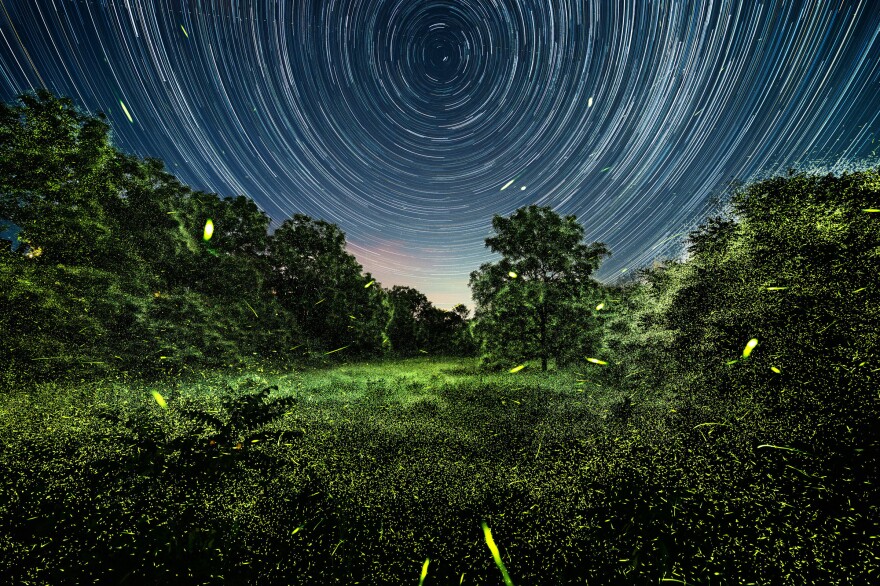Photographer Pete Mauney heads out for work each night, flashlight in hand, wearing highway safety gear. His oversized, orange T-shirt and its strip of reflectors match the traffic cones piled in the trunk of his car.
"Almost everybody thinks I'm a surveyor," he says. "Except state troopers."
During the summer months, from dusk until the moon rises, he finds his subjects along quiet stretches of farmstand highway, in abandoned fields and hidden pockets of woods, and the grassy tracks underneath power lines within a 30-mile radius of his home in Tivoli, New York. Mauney photographs fireflies — that is, any night the temperature stays above 60 degrees and there isn't a downpour.

"I never get tired of it. And I never get tired of the challenge and the puzzle of trying to construct the images — and trying to construct a good image, because it's not enough for me to let the bugs do the heavy lifting. Almost any picture with some fireflies in it is going to look cool, but that doesn't necessarily make it a good photo, compositionally."
For Mauney, a good image starts with the right location.
"I often work by power lines," he explains. "They're kept clear of trees — it's just brush, which fireflies love. For the most part, they prefer unpopulated areas where nobody bothers them and there's no light.
"Farms can have these giant old mercury vapor lights or LEDs that blast in all directions. There's one spot I know where the barn blocks most of the light on one side of the field and the population is very active in that area, but the part of the field being hit by the farm light only has about 20% of that activity — even though it's hundreds of feet away from the source."


On the night I tagged along with Mauney, he picked a spot to photograph alongside a quiet stretch of road. Working by starlight, he set up his camera on a tripod and pointed it toward a line of trees with an electrical tower behind it. He took some sample pictures at a higher brightness so that he could check the composition, but a tiny porch light from a house behind us was lighting up the bushes, spoiling the shot. When the home's owner suddenly emerged, alerted to our presence by an overzealous goldendoodle, Mauney talked him into turning it off.
Then, it grew very dark. Once my eyes adjusted, I saw thousands and thousands of dancing lights: in short bursts and more sustained flashes, making patterns that hover and float. Mauney will leave his camera in the same position for up to five hours, collecting as many as 800 timed exposures. He compiles these in Photoshop, layer by layer, creating single images.


"There was a night when the fireflies were about as active as I've ever seen them on either side of a road," Mauney remembers. "One side had a species that flashes quickly. The other side had a kind that leaves snake-like tracks. The photograph I made on the first side looks like the most serene environment you could imagine, with all of the surfaces covered in green light — a spa for the eyes. The picture from the other side was almost pure chaos.
"Having thousands of these creatures almost completely fill your field of vision is not serene or romantic," he continues, "well, unless you're a firefly. It can actually be stressful — it elevates my heart rate. I've been trying to see if I can fill an entire frame with their flashes, and I've gotten pretty close."
"Pete's photos are amazing," says computer scientist and biophysicist Dr. Orit Peleg, who leads a research team that studies insect communications at the BioFrontiers Institute of the University of Colorado, Boulder. "They stand out in part because here's so much activity in the areas where he's working."

This summer, Mauney has been one of 10 volunteers across the country helping Peleg's team collect data on fireflies. They sent him two GoPros that he can deploy when he's already out in the field; positioned back-to-back, they capture 360-degree video that will be stitched together to create 3D models. Peleg's team used this method to offer new evidence that firefly swarms can synchronize their flashes. Their goal is to produce the first dictionary that will match firefly species with their distinctive flash patterns.
"Once we can identify the different species," Peleg says, "we can plug them into conservation monitoring and try to correlate our observations with environmental factors, such as light pollution, pesticides and habitat destruction that are impacting the fireflies."

Although Mauney is an artist and not a scientist, it's not lost on him that his photographs shed new light on how his favorite subjects coexist with us, for better and for worse. They document places that don't exist on any map, and yet are critical to the fireflies' survival. With our eyes opened to these hidden hubs of activity, we can't help but question what else we might be missing.
"The bioluminescent insects are a tiny, tiny, tiny, tiny percentage of all the other insects that are out there that we're not seeing," says Mauney. "They're giving us an indication, through the photographs, of what else is there — which is a lot. There is a lot that we don't see."


Find more of Pete Mauney's work online at ninetyninenorth.com or follow him on Instagram at @pete_mauney.
Copyright 2023 NPR. To see more, visit https://www.npr.org.



